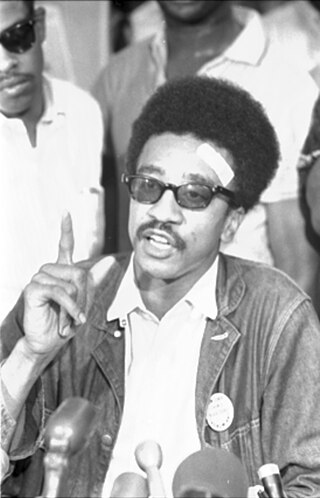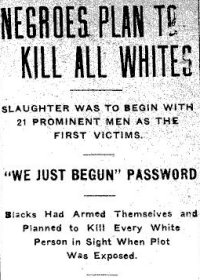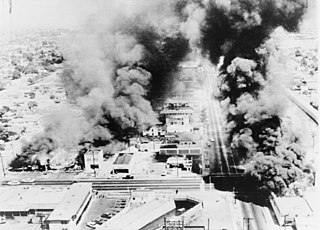In the broader context of racism against Black Americans and racism in the United States, mass racial violence in the United States consists of ethnic conflicts and race riots, along with such events as:

Robert George Seale is an American political activist and author. Seale is widely known for co-founding the Black Panther Party with fellow activist Huey P. Newton. Founded as the "Black Panther Party for Self-Defense", the Party's main practice was monitoring police activities and challenging police brutality in Black communities, first in Oakland, California, and later in cities throughout the United States.

Jamil Abdullah al-Amin, formerly known as H. Rap Brown, is a human rights activist, Muslim Cleric, Islamic separatist, and convicted murderer who was the fifth chairman of the Student Nonviolent Coordinating Committee (SNCC) in the 1960s. During a short-lived alliance between SNCC and the Black Panther Party, he served as their minister of justice.

Fredric Wertham was a German-American psychiatrist and author. Wertham had an early reputation as a progressive psychiatrist who treated poor black patients at his Lafargue Clinic at a time of heightened discrimination in urban mental health practice. Wertham also authored a definitive textbook on the brain, and his institutional stressor findings were cited when courts overturned multiple segregation statutes, most notably in Brown v. Board of Education.

On December 7, 1993, a mass shooting occurred aboard a Long Island Rail Road (LIRR) train in Garden City Park, New York. As the train arrived at the Merillon Avenue station, passenger Colin Ferguson began firing at other passengers with a semi-automatic pistol. Six of the victims were killed and nineteen others were wounded before Ferguson was tackled and held down by other passengers on the train.

The Elaine massacre occurred on September 30–October 2, 1919 at Hoop Spur in the vicinity of Elaine in rural Phillips County, Arkansas. As many as several hundred African Americans and five white men were killed. Estimates of deaths made in the immediate aftermath of the Elaine Massacre by eyewitnesses range from 50 to "more than a hundred". Walter Francis White, an NAACP attorney who visited Elaine shortly after the incident, stated "... twenty-five Negroes killed, although some place the Negro fatalities as high as one hundred". More recent estimates in the 21st century of the number of black people killed during this violence are higher than estimates provided by the eyewitnesses, and have ranged into the hundreds. Robert Whitaker estimated 856 people were killed in his 2008 book on this topic. The white mobs were aided by federal troops and local terrorist organizations. Gov. Brough led a contingent of 583 US soldiers from Camp Pike, with a 12-gun machine gun battalion.

William Moses Kunstler was an American lawyer and civil rights activist, known for defending the Chicago Seven. Kunstler was an active member of the National Lawyers Guild, a board member of the American Civil Liberties Union (ACLU) and the co-founder of the Center for Constitutional Rights (CCR), the "leading gathering place for radical lawyers in the country."

The Watts riots, sometimes referred to as the Watts Rebellion or Watts Uprising, took place in the Watts neighborhood and its surrounding areas of Los Angeles from August 11 to 16, 1965.

Richard Benjamin Speck was an American mass murderer who killed eight student nurses in their South Deering, Chicago, residence via stabbing, strangling, slashing their throats, or a combination of the three on the night of July 13–14, 1966. One victim was also raped prior to her murder. A ninth potential victim, student nurse Corazon Amurao, survived by hiding beneath a bed.

The Crown Heights riot was a race riot that took place from August 19 to August 21, 1991, in the Crown Heights section of Brooklyn, New York City. Black residents attacked Orthodox Jewish residents, damaged their homes, and looted businesses. The riots began on August 19, 1991, after two children of Guyanese immigrants were accidentally struck by a car running a red light while following the motorcade of Rebbe Menachem Mendel Schneerson, the leader of Chabad, a Jewish religious movement. One child died and the second was severely injured.

Mark James Robert Essex was an American serial sniper and black nationalist known as the "New Orleans Sniper" who killed a total of nine people, including five police officers, and wounded twelve others, in two separate attacks in New Orleans on December 31, 1972, and January 7, 1973. Essex was killed by police in the second armed confrontation.

Most Evil is an American forensics television program on Investigation Discovery, first aired in 2006, presented by forensic psychiatrist Dr. Michael H. Stone of Columbia University during the program's first three seasons, and by forensic psychologist Dr. Kris Mohandie during its fourth season. On the show, the presenter rates murderers on a scale of evil that Stone himself has developed. The show features profiles on various murderers, serial killers, and mass murderers of various degrees of psychopathy. The series initially ran for three season, from 2006 to 2008, and was later revived for a fourth season, from 2014 to 2015.

The Fort Lawton riot refers to a series of events in August 1944 starting with a violent conflict between U.S. soldiers and Italian prisoners of war at Fort Lawton in Seattle, Washington during World War II. After the riot, prisoner Guglielmo Olivotto was found dead. This led to the court-martial of 43 soldiers, all of them African Americans.

Badge of the Assassin is a 1985 television film starring James Woods, Yaphet Kotto and Alex Rocco. It was directed by Mel Damski. The film first aired on the Columbia Broadcasting System network on November 2, 1985. The film's production company was Blatt-Singer Productions.
William Henry Grier was an American psychiatrist. He was born on February 7, 1926, in Birmingham, Alabama, the son of Henry Grier, a postal worker who lost his job when Grier was 12; the family subsequently moved to Detroit, Michigan, to live for a time with family.

The Morgan County, West Virginia race riot of 1919 was caused by big business using African-American strikebreakers against striking white workers in Morgan County, West Virginia.
Price Mashaw Cobbs, M.D. was a psychiatrist, civil rights leader, author and management consultant. He published extensively about racism and created a clinical model called Ethnotherapy. He was one of the founders of the African American Leadership Institute Anderson School of Business at UCLA and a Life Member of the NAACP. He co-authored two books with William Grier, Black Rage and The Jesus Bag and co-authored Cracking the Corporate Code with Judith L. Turnock.

Charles Henry Pitman Sr. was a lieutenant general in the United States Marine Corps who served as Deputy Chief of Staff for Aviation. He was also involved in the 1980 Operation Eagle Claw. Pitman retired in 1990 and died of cancer in 2020.















